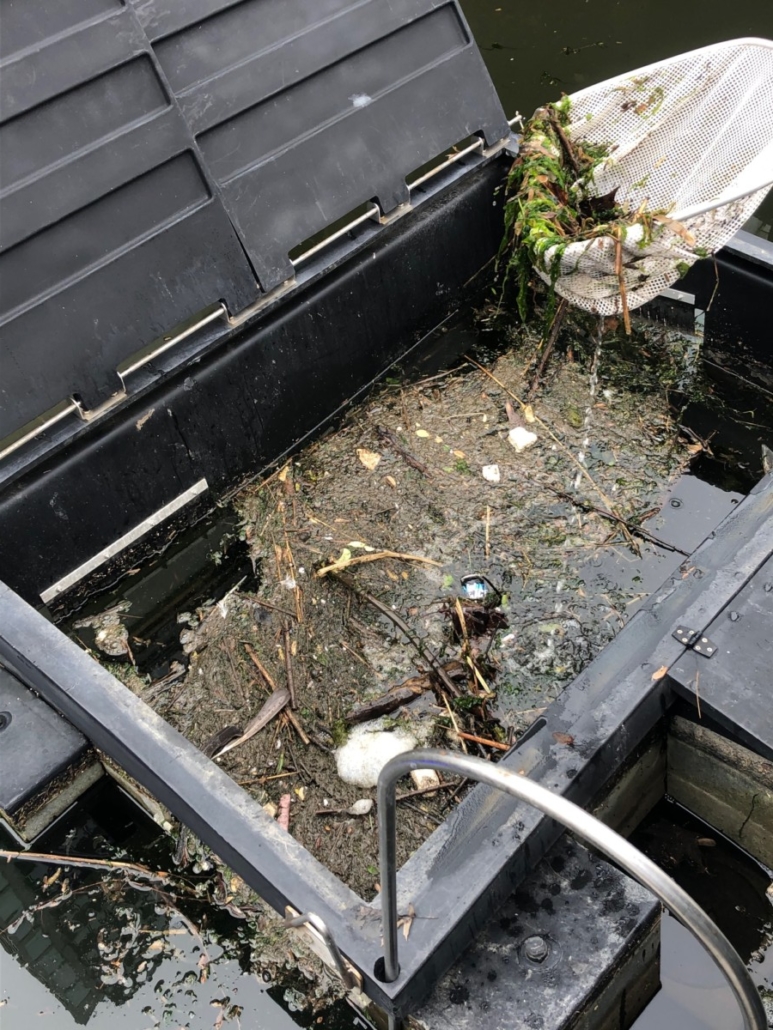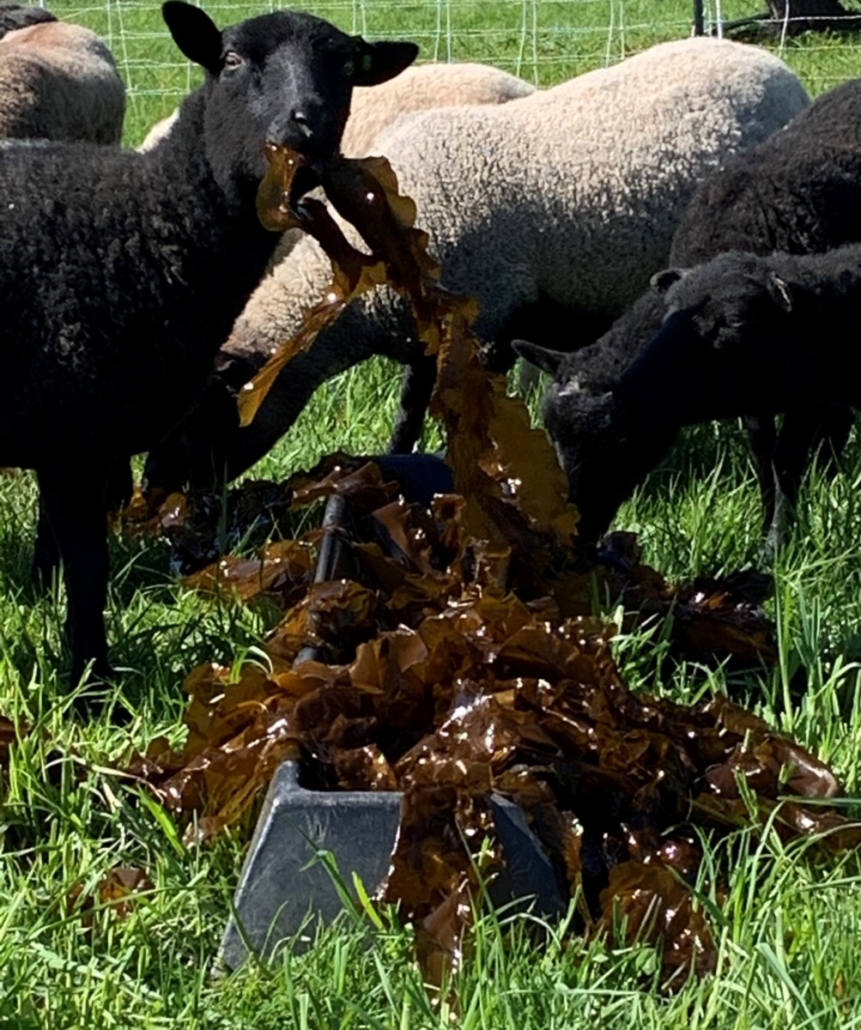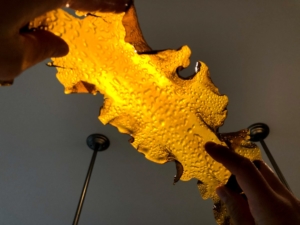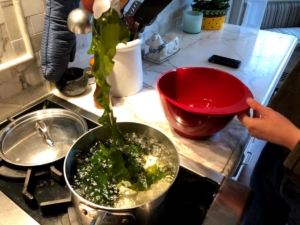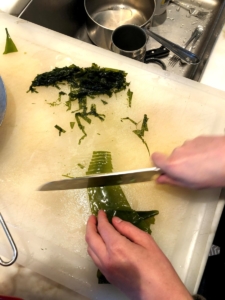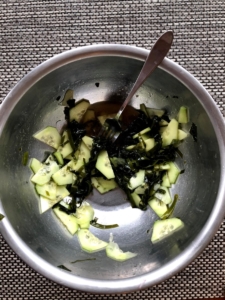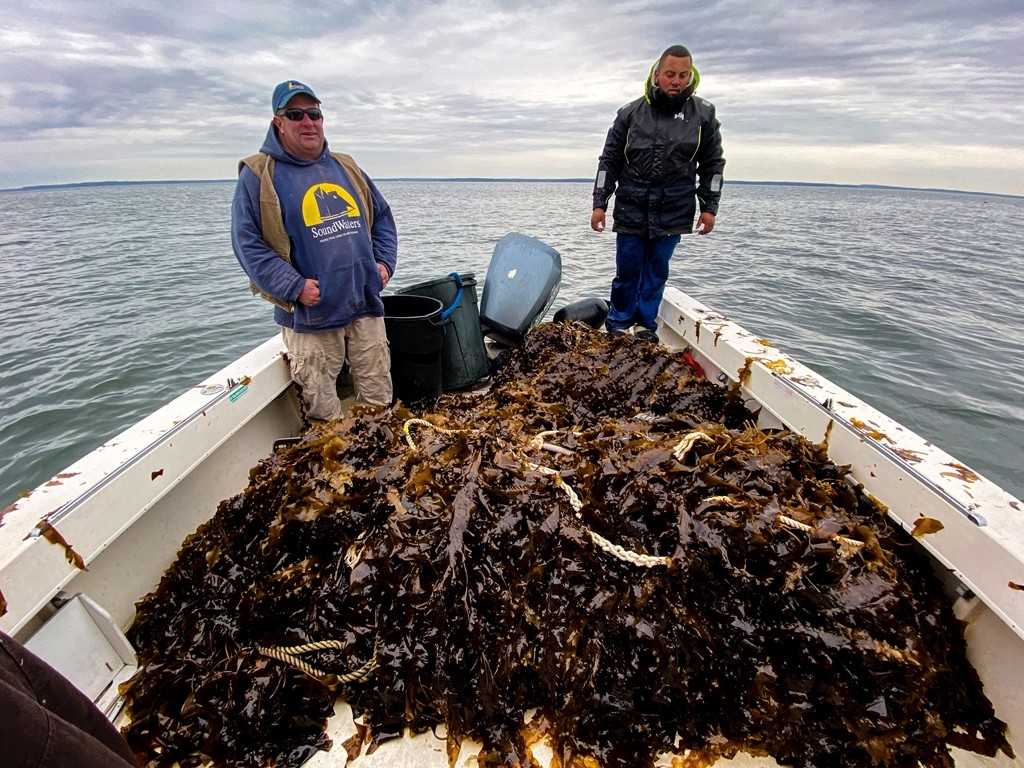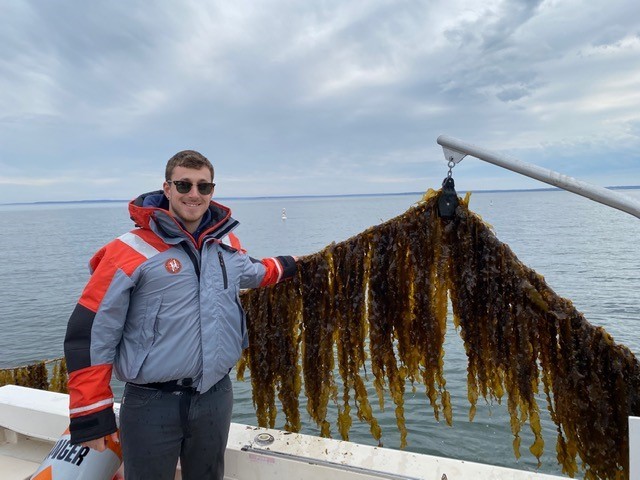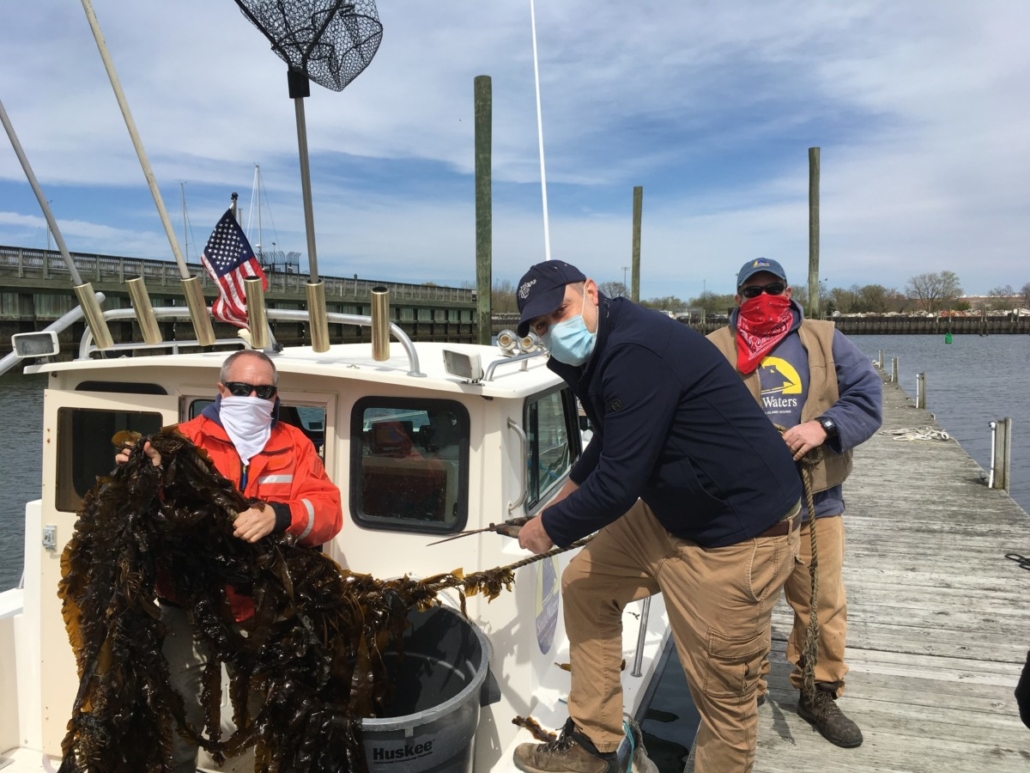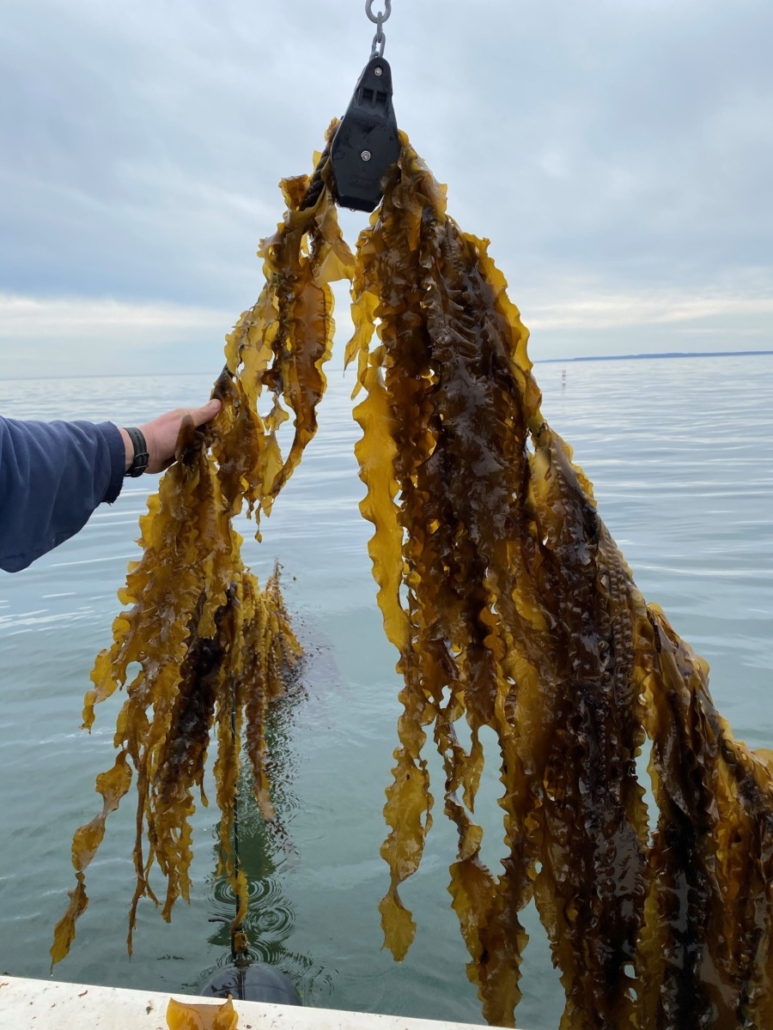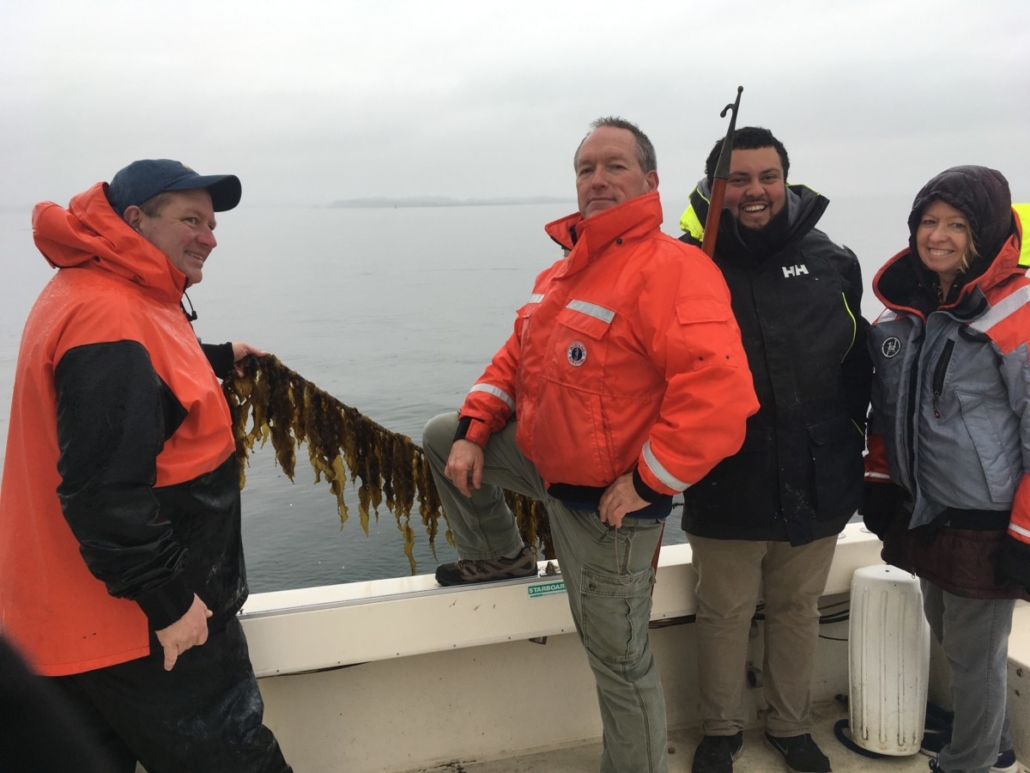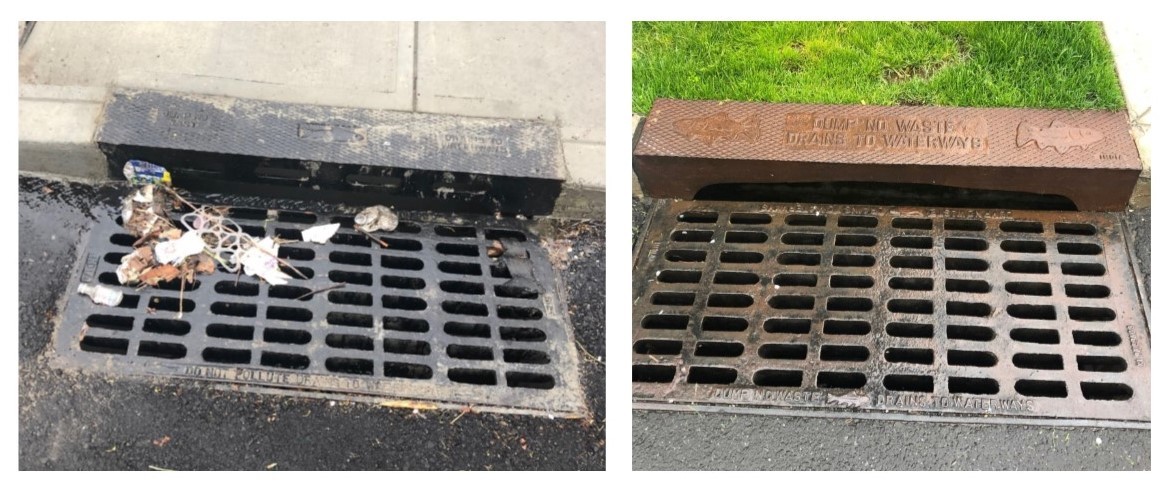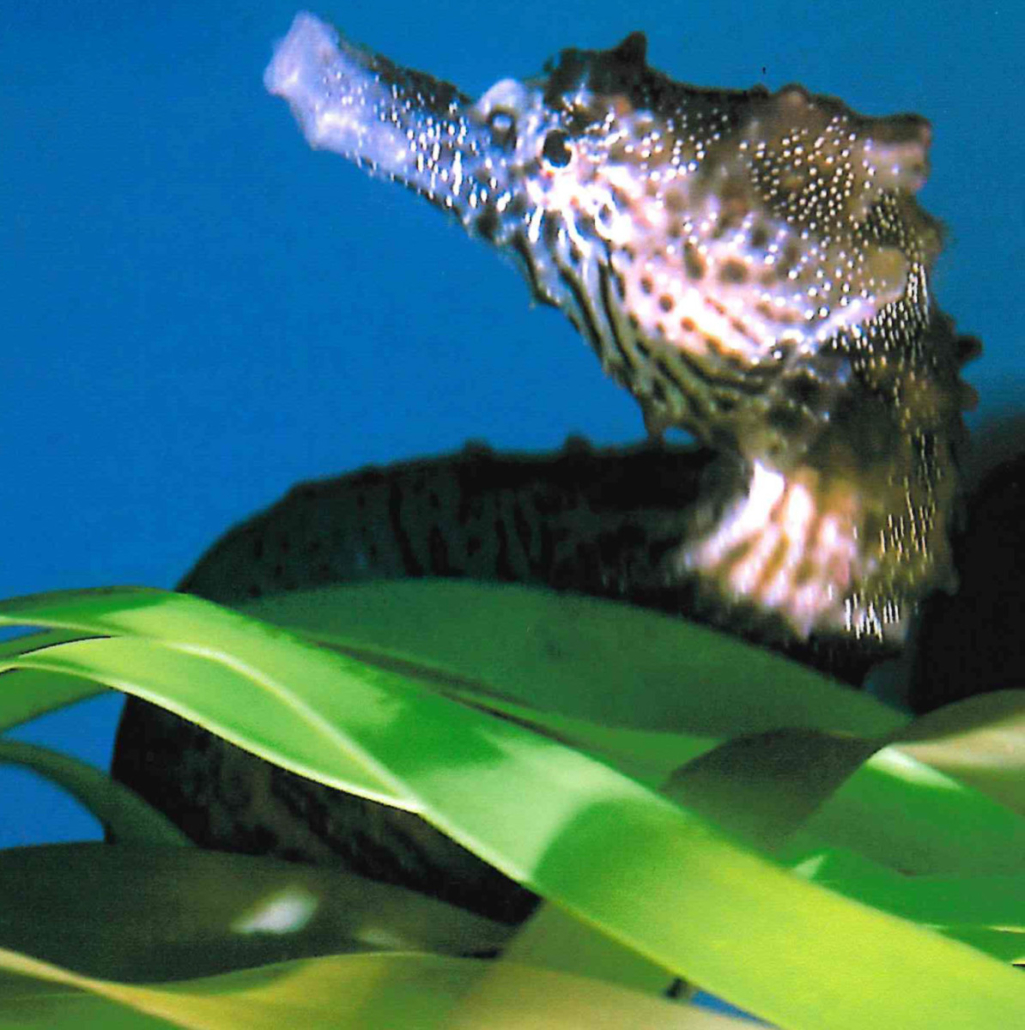Research at SoundWaters
Four years ago, we added a research vessel to the SoundWaters fleet and opened up endless new opportunities for our educators and students to work on Long Island Sound. The vessel makes possible our work with kelp and oysters and provides an excellent classroom for older students to study the Sound. The research vessel also makes it possible for us to conduct…research. In today’s video, Jess explains one research study we are currently supporting, the Unified Water Study, to monitor water quality in bays and harbors across the Sound.
From May to October, four mornings each month, Jess and her team are on the research vessel before dawn testing the water in Stamford Harbor and Holly Pond. The data we contribute to the study, combined with data collected by 21 other groups around the Sound allows researchers to report on the overall health of Long Island Sound.
June 4, 2020 – Tracking Animals in Long Island Sound
Tracking Animals in Long Island Sound
A horseshoe crab is the star of the show again today and helps us answer a great question: When scientists quote statistics about animal populations and movement in Long Island Sound, how do they actually know? Jess explains it very clearly in today’s video using a horseshoe crab as a great example.
Are you a Citizen Scientist?
The Sacred Heart University study Jess refers to in the video will only succeed with help from all of us. If you see a “tagged” horseshoe crab on the beach, it’s your turn to help. Get only close enough to see the tag number and then report it at fws.gov/crabtag. You’ll be providing important data to the study and you’ll learn how far that crab has moved since it was tagged. You can even track where your horseshoe crab moves in the future…as long as other citizen scientists do their job.
June 3, 2020 – Look, Don’t Touch
If you spend any time at the beach over the next few weeks – and we hope you do – there is a good chance you will witness a ritual that is almost 450 million years old. It’s June and that’s mating season for the horseshoe crab. Check out today’s video below for a peak at the action and don’t be embarrassed; they’re not. The female will lay her eggs in the sand to be fertilized by the trailing male.
If you want to see the horseshoe crabs for yourself, visit the beach during high tide, ideally during a full or new moon. If you do see them, watch from a distance. The biggest danger this ancient creature faces is from humans.
May 29, 2020 – How deep is Long Island Sound?
How deep is Long Island Sound?
The answer to this question, of course, depends on where you want to measure, but in today’s video, Captain VG of the schooner SoundWaters makes it very simple.
Here’s are some hints: if you dropped the Statue of Liberty into the Sound at its average depth, you would see Lady Liberty from the waist up, but at the Sound’s deepest point she would have to stand on her tippy toes to keep the torch lit.
Relatively speaking, Long Island Sound is the baby pool. The average depth of the Atlantic Ocean is 10,925 feet. Lady Liberty would need one big life jacket.
May 28, 2020 – Going, Going, Gone
Let’s go big and it doesn’t get much bigger than climate change. Melting polar ice caps, sea level rise and coral bleaching in the Great Barrier Reef are all huge effects of a warming climate. On Long Island Sound, the effects of climate change may not be so widely publicized, but that doesn’t mean our favorite body of water is not immune.
The Lobster
In today’s video, Leigh doesn’t go big; she goes small – to the lobster – because the lobster is a great example of the cause and effect of climate change on Long Island Sound. Like it or not (we vote “not”), the lobster is moving on so whether you like your lobsters in the water or on a plate, let’s enjoy them while they’re still here.
May 27, 2020 – Talking Trash
We know death and taxes are two guarantees in life, but sometimes it seems there is a third: trash in the water. Even as we hear that our self-quarantining is having a positive effect on our environment, the trash continues to flow. Every day we open the lid of our trash skimmer in Stamford Harbor at Harbor Point and we never know what we’re going to find, but we can (almost) guarantee we’ll find something that doesn’t belong there.
Below is a photo of this morning’s “ah ha” moment and here’s a partial list of what we found:
Beer can
Wine bottle top
Rubber glove (ugh!)
A woman’s shoe (scary!)
Plastic bag (making a comeback?)
7 cigarette butts (always a favorite)
Packing peanuts
Many tiny bits of Styrofoam
Why a Trash Skimmer?
Yes, it removes debris from the water 24/7, but we also weigh, sort and count the debris to learn what it is, where it comes from and hopefully, how to prevent it. We contribute all the data to our partners at Clean Ocean Access and 11th Hour Racing to support the study of marine debris in the New England and Mid-Atlantic regions. One thing we can guarantee is If there is a solution to the marine debris problem, this team will find it.
May 26, 2020 – When Low Tide Doesn’t Stink
If you want to explore the shoreline, low tide is your friend. Low tide exposes the intertidal zone, which, as Christina explains in today’s video, is brimming with the activity of animals uniquely adapted to live in this area of extremes (air, temperature, salinity and predators). Some of that activity actually creates the distinctive rotten eggs odor we identify with low tide.
If you do go exploring, remember to take only pictures and leave only footprints. The one extreme the animals are not equipped to deal with is human impact.
May 22, 2020 – Drinking With Oysters
What Do You Drink With Oysters?
Well, the weekend’s here and you’ve (hopefully) ordered your oysters from Stella Mar. You know how to shuck them and serve them so the last question is what do you drink with them?
In today’s final video of SoundWaters Oyster Week, Tim, one of our educators, jumps behind the bar and shows us how to mix up three cocktails enjoyed by oyster lovers. Light and refreshing, these drinks will make a great oyster even better.
Prefer beer with your oysters? Get your order in now to Stamford’s Half Full Brewery and they’ll have it ready for you when you arrive.
More of a wine & oysters person? Here is some guidance on selecting just the right wine.
Whatever you drink, enjoy your oysters.
They’re a local treat. Happy Memorial Day.
May 21, 2020 – Serving Oysters
How Do You Serve Oysters
We know we love to eat oysters, but when it comes to serving them, we’re calling on an expert: Steve Costanzo of Olio Restaurant in Stamford. In today’s video, Steve shows us a quick and simple way to add wonderful flavor to your oysters with a classic mignonette.
Mignonette is a French word that translates to “favorite.” With oysters, it just means “delicious.”
Oysters for Memorial Day
And now that you know, you can put your new skill to work this weekend on fresh Long island Sound oysters from Stella Mar. Visit StellaMarOysters.com/shop all week and order your oysters for Memorial Day weekend. Steve will hand them to you personally on Saturday morning at 10am at Harbor Point in Stamford.
May 20, 2020 – Aw Shucks!
May 19, 2020 – The Perfect Oyster?
Who Wants A Great Oyster?
We all do, but what makes a great oyster? In today’s video, we’ve asked an expert, Steve Schafer from the Stella Mar Oyster Company, to give us some tips on what to look for when we buy oysters.
What’s Your Perfect Oyster?
If it’s fresh from Long Island Sound to your plate on Memorial Day weekend after you haven’t had an oyster in months, then here’s your chance:
Order: Online by Friday: StellaMarOysters.com/shop
Pick up: Saturday at 10am at Harbor Point in Stamford
Enjoy the Perfect Oyster: All Memorial Day weekend
May 18, 2020 – Oysters For You
Give me oysters and beer, for dinner every day of the year, and I’ll be fine.
Jimmy Buffett
Let’s face it: We like oysters because they’re good for Long Island Sound, but we LOVE oysters because they’re good to eat.
Welcome to Oyster Week
Every day this week, we’ll bring you a short video about enjoying oysters – buying, shucking, serving and of course, drinking – to get you ready for the season. Today, Christina introduces you to Stella Mar Oyster Company and takes a quick trip to their farm. Their oysters are beautiful and ready to harvest.
Oysters for You – Harvested to Order
Place your oyster order with Stella Mar this week and pick them up directly from the oysterman on Saturday morning at 10am at Harbor Point in Stamford and enjoy them all Memorial Day weekend. You’ll never enjoy fresher oysters and you’ll be supporting a local business.
May 15, 2020 – Follow the Kelp…back to the Farm
Follow the Kelp…back to the Farm
All week we have followed the story of kelp: Growing from seedlings to 6’ blades in our underwater farm; its ability to remove nitrogen and clean our local waters; its potential as new income for fishermen and its wonders as a healthy food for us. On this last day of Kelp Week, we follow the kelp inland, to local farms, where kelp is being worked back into the earth.
Closing the Loop
A critical ecological concept is the “closed loop,” where inputs and outputs are in balance. In a closed loop, no excess pollutants flow downstream or escape into the air. A closed loop is everyone’s goal, but it’s an elusive one in our modern world.
Kelp helps close the loop for Long Island Sound. Excess nitrogen flows into the Sound through fertilizers, leaky sewage systems, etc., but as kelp grows, it takes up that nitrogen. When SoundWaters removes the grown kelp and shares it with local farms, we are removing the nitrogen from the water and putting it back into the soil through a healthy, slow release process.
Farmers have many uses for kelp. Some farms, like Fairgate, are composting the kelp while others are using it as mulch. And in a fan favorite, Millstone Farms is feeding the kelp to their livestock, making for the cutest kelp photos ever!
Next Week is Oyster Week
This is the end of Kelp Week, but don’t worry…. next week SoundWaters goes BIG with Oyster Week. We’ll share how to buy, shuck, serve and enjoy oysters. If you want a head start, go to StellaMarOysters.com/shop and purchase fresh oysters direct from our local oysterman.
I’m addicted to seaweed.
I must seek kelp.
Eat kelp? Before you pass judgement, it’s worth taking a quick look at how another crop, kale, took the world by storm. Remember when kale was just the garnish on the sandwich tray, the leafy green backdrop to the real meal? Then it took center stage and became the go-to vegetable. The lesson from kale is we can reconsider old habits and find new uses for overlooked foods.
There are two reasons to eat kelp: it’s good for humans and it’s good for the planet. Let’s start with the planet. Our current modes of food production are unsustainable. Industrial agriculture is particularly hard on the environment – impacting air, soil and water pollution on a colossal scale. Kelp, on the other hand, flourishes with no chemical inputs (no fertilizer, pesticides nor herbicides) and no negative impacts. On the contrary, growing kelp is a net environmental positive, as kelp uptakes nitrogen and carbon and improves water quality. Kelp, with no negatives and many positives, is good for Planet Earth.
Kelp is also good for humans. It is high in vitamins A, B1, B2, C, D and E and key minerals including zinc, iodine, magnesium, iron, potassium, copper and calcium (kelp actually has the highest natural concentration of calcium of any food- 10x’s more than milk!). Kelp is a healthy food for people and for our planet.
How to cook kelp? Many cooks have many perspectives- from kelp noodles to kelp jerky to kelp salad. Long Island Sound kelp has a nutty, salty taste that works great as a side with fish or as a stand-alone dish. The photos below, from SoundWaters Board member, Randy Bourne, offer a quick tutorial on kelp as it looks right off the boat, then quickly blanched, chopped and served as a salad.
Got Kelp? We sure do!
Are we in week seven of Stay-at-Home? Or is it week eight or nine? To help us keep track, we’ve started to give each week a name. This week is Kelp Week.
Kelp – that astounding sea vegetable (also known as seaweed) – is a new take on an old concept. We all know seaweed, or we think we do. It’s the greenish wet leaves that appear on the shoreline or amid the rocks: seemingly not much to see nor much to consider.
Except that seaweed (also known as kelp) is a plant of extraordinary power and potential. More than just a plant that grows in the water: kelp is a crop, kelp is a job and kelp is a nature-based solution to improving our local environment.
Kelp as a Crop.
You already eat seaweed, perhaps in sushi or occasionally as a snack, yet nearly all seaweed sold in our country is currently imported. Locally sourced seaweed is on the rise with farmed kelp increasingly on the menu and brewed in beers. The potential for kelp as a food crop is enormous, with the added benefit of key nutritional value. Additionally, kelp as a crop is widely sought after by farmers, who value the kelp for mulch, compost and animal feed.
At SoundWaters we had big plans this spring to share our harvest with local restaurants and the local brewery. Those plans got put on hold due to COVID 19, but we were able to share our crop with five local farmers who were all thrilled to experiment with the kelp. One of our farming partners, Fairgate Farm, explained that they are “thrilled to be partnering with SoundWaters on this project. Kelp is loaded with trace minerals which can often be deficient in soil, and also has amazing properties which encourages healthy, vigorous, and abundant plant growth! That’s why we’ll be working this kelp into our compost and garden beds.”
Kelp as a Job.
As kelp becomes a crop it has the potential to become a key part of the local marine economy with jobs and revenue through the colder months. In Maine, the regional leader in kelp production, the Island Institute determined that farmed kelp production could grow an average of 12% – 15% annually.
Here is in Connecticut, the industry is smaller, yet Long Island Sound is home to several kelp growers, including our technical partner, GreenWave, the nonprofit led by Bren Smith, a nationally-recognized leader dedicated to bringing the potential of kelp to reality. Kelp can be a significant economic boost by creating off-season waterfront jobs.
Kelp can improve local waters
In addition to being a crop and a job creator, kelp is a nature-based solution to one of our region’s most intractable environmental problems: dead zones in Long Island Sound.
The clearest way to follow the story from seaweed to dead zones is to follow the nitrogen. Nitrogen is a by-product of our collective lives: excess nitrogen flows into the Sound from sites ranging from suburban lawns to leaky septic systems to flawed sewage treatment plants. Too much nitrogen leads to an overgrowth of algae. Once that algae decomposes, it sucks the oxygen out of the water. Too little oxygen leads to… dead zones where fish and other animals cannot survive.
As kelp grows it uses (or “uptakes”) nitrogen naturally. Once the kelp is harvested, that nitrogen is removed from the water. A leading researcher of the potential of kelp to remove nitrogen is UCONN Professor Charlie Yarish, whose research work has projected that if kelp were farmed on 1.5% of the Sound, it could remove nearly 6 million pounds of nitrogen each year.
Kelp is a “no-brainer”
In a world that needs good news, the news from kelp is all good. It’s a crop that uses no chemicals (no herbicides, pesticides or fertilizers); it’s a healthy food; it creates jobs and it improves the environment.
As Farmer Pete, from Fairgate Farms, notes, “the fact that [SoundWaters] uses this kelp to clean our waters and pull out excess nitrogen, and in turn we can use it to improve our soil and grow the healthiest food possible for our community…this partnership is a no-brainer.”
And, yes, it tastes great.
More Kelp this week?
We’re only halfway through kelp week. Still to come, we’ll follow kelp to the farm and to the kitchen.
Next Week? Oyster Week of course, when you’ll have the chance to purchase oysters directly from the oysterman at StellaMarOysters.com.
May 12, 2020 – Krazy for Kelp
How Does the Kelp Grow?
While the SoundWaters team is clearly Crazy for Kelp (we are, after all, the folks who created Kelp Week!), even we recognize that a visit to a kelp farm can be a bit… underwhelming. The only signs of activity are a bunch of buoys and markers bobbing in the water. That is because, as we saw in yesterday’s video, all the action on a kelp farm happens below the surface.
How does kelp grow? Underwater is where it all happens. A kelp farm is set up like an upside-down vineyard, with the kelp growing downward, from long lines strung a few feet below the surface. The kelp attaches to the lines with root-like “stipes” and then grows steadily through the winter, with the blades reaching depths of five to eight feet.
The lines are held firmly in place by strong anchors and moorings that are critical, given the power of wind, tides and winter storms. Throughout the winter the SoundWaters team rides out to the farm weekly to measure growth, check the moorings and fix any lines or buoys that have gone astray.
Working on the water all winter is both hard (cold, wet and stormy) and exhilarating (cold, wet and stormy). The SoundWaters farm is made possible through hard work and terrific partners, including project funders (the National Fish and Wildlife Foundation (NFWF) and the US EPA and our technical partners at GreenWave.
Ever wonder just why the SoundWaters team is so Crazy for Kelp? Stay tuned for tomorrow’s episode of Kelp Week, as we explore the astounding potential of kelp as food, kelp as a job and kelp as a nature-based solution to improving our local environment. And you thought it was just seaweed!
And remember – Next week is Oyster Week so if kelp doesn’t tickle your palate, oysters surely will and you will have the chance to enjoy them for Memorial Day.
May 11, 2020 – Kelp Underwater
Welcome to Kelp Week.
Boats are showing up at the marinas and anglers are popping up along the shore. Long Island Sound seems like it’s waking up after a long winter sleep and, as everyone always says, it can’t happen soon enough. Hot weather and cool water are a wonderful combination.
If You Can’t Stand the Cold, Get Out of the Kelp Boat
For kelp farmers – and with last week’s harvest, SoundWaters is officially a kelp farmer – the opposite is true. Kelp is a winter crop that thrives in cold weather so the SoundWaters team has been busy on the water all winter seeding and tending our four-acre kelp farm off Great Captain Island in Greenwich. Yes, it has been bitterly cold, but it has also been peaceful and beautiful and, as we will show you all week, kelp plays an important role in our ecosystem and potentially, in our nutrition.
In today’s video, however, just enjoy the balletlike images of a small, but thriving kelp forest in Long Island Sound.
Next week is Oyster Week and your chance to enjoy the freshest of Long Island Sound oysters direct from Stella Mar.
May 8, 2020 – Ahhh, Sea Breezes
When you close your eyes and see yourself at the beach enjoying a glorious vacation, what is your first sensation? Sun? Maybe. Water? Possibly. A beautiful sea breeze? Definitely. Sea breezes are the stuff of dreams and the lyrics of love songs. A nice sea breeze makes a pretty day gorgeous and a hammock irresistible. But why is that breeze only at the beach and not at your house?
In today’s video, Mike takes all the romance out of sea breezes, but he gives us back a great explanation of how sea breezes form. It’s science, but you’ll be surprised how simple it is and if you check out the additional resources, you’ll even start to understand those crazy summer weather patterns.
If you want to put some of the romance back in or pretend you are on the beach, this link will help you get started.
Sea Breezes
How do sea breezes work?
A Sea Breeze Experiment For Home
What about land breezes?
May 7, 2020 – Preying for Osprey
Maybe this was a good story for Earth Week a few weeks ago, but there’s never a bad time for good news. At SoundWaters, we are always looking for nature’s clues that her health is improving and one bellwether has been the increasing number of Osprey returning to Long Island Sound each spring.
So What’s The News?
It’s actually good news on two fronts. Osprey suffered greatly when we were using harmful pesticides, like DDT, during the 1950s and 60s. Our pesticides were leeching into our waterways and Long Island Sound where they were taken up by fish. The Osprey, who are perfectly adapted fish hunters, ate the fish and received concentrated amounts of pesticides, which weakened their eggshells so much they were crushed when adults nested on them. DDT was banned in the 1970s and ever since, the Osprey population has been making a gradual, but consistent return.
The other good news is fish, which thrive in a healthy environment. Osprey eat fish almost exclusively and they will go where there is plenty to eat. The fact that Osprey numbers continue to grow so many decades after DDT was banned indicates that our waters are still improving and fish populations are increasing.
Conservationists have constructed Osprey nesting platforms up and down Long Island Sound so there’s a good chance you’ll see this bird of prey if you’re around tidal wetlands. If not, there is a link in the additional resources to a wonderful live Osprey Cam.
Live Osprey Cam (North Fork of Long Island)
All About Ospreys
Osprey Numbers in Connecticut
May 6, 2020 – In The Beginning…
Your parents won’t remember it and even their parents won’t remember it, but there was a time when neither Long Island nor Long Island Sound existed. You have to go pretty far back, which is where Nicola and Jess take you in today’s video, to learn when and how the Sound was created. Fun fact: Did you know that Long Island Sound was originally a lake? Lake Connecticut, and it extended from New York City to Martha’s Vineyard.
The Sound was formed practically yesterday by geological standards – over a period spanning 30,000 BP (years Before Present) to 11,000 BP. By comparison, dinosaurs roamed Connecticut over 200 million BP. If you can imagine a sheet of ice 1,000 feet high moving south across Connecticut you can better comprehend the incredible forces that changed our landscape so dramatically.
The Evolution of Long Island Sound
How Glaciers Shaped Connecticut’s Shoreline
Long Island Sound’s Formation
May 5, 2020 – Sweet Stamford Harbor
When you Google “Stamford” and “chocolate,” you’ll find listings for some very fine area chocolate shops, but if you go a few pages deeper, you’ll uncover a little bit of Stamford’s really sweet history. In the early 1900s, Stamford became the first American home of a very large German chocolatier, the Stollwerck Chocolate Company, located directly on Stamford Harbor, right where the Crab Shell and Prime restaurants are today. The building is still in existence today and is currently being renovated to become a high tech science lab.
Stollwerck, founded by five sons of a baker, expanded to Stamford from Cologne in 1904 with the purchase of 43 acres of land on Southfield Avenue. One of the sons tragically died when he fell into a vat of chocolate and drowned. The Stollwerck’s American experience doesn’t improve too much after that tragedy. Just a few years later, in the midst of World War 1, the U.S. government seized the factory under the “Trading With The Enemy Act” (TWEA), effectively ending Stamford’s place in chocolate history. The Stollwercks survived the war and are still selling chocolate today. They even credit “Stanford, USA” (sic) in the history of the company.
Looking for more Stamford Harbor history? Plan to join the Stamford Historical Society on a Harbor History Boat Tour at SoundWaters HarborFest on August 29.
May 4, 2020 – Oysters Vs Clams
Oysters or clams. Clams or oysters. Does it make a difference?
They look very different and discriminating palates would say they taste very different, but how different are they? In the video below, Jess compares and contrasts how clams and oysters look and function. The more you learn about these mollusks, the more there is to like. They’re good for the environment, they’re good to eat (nutritious and tasty) and they’re good for the local economy.
Coming Up: Oyster Week
Starting on May 18, we’ll pay a week’s worth of homage to the oyster. Each day of Oyster Week we’ll bring you a different feature on this shellfish that means so much to the Long Island Sound environment and economy. You’ll even have the opportunity to purchase fresh oysters directly from the oysterman.
May 1, 2020 – Just a Pile of Rocks?
Breakwaters are enormous and they’re hard to miss, but they are easy to take for granted. In today’s video, Christina introduces us to the breakwater that has protected Stamford Harbor since 1941 and explains how it absorbs the tremendous forces thrown at it from Long Island Sound.
Breakwaters may look like just piles of rocks, but they’re highly engineered structures. Stamford’s is actually two breakwaters spanning 3,100’ with a 200’ opening between them for a navigation channel. It was built by the US Army Corps of Engineers at a cost of $398,000 and required 160,000 tons of stone. So if it is just a pile of rocks, at least, it’s a BIG pile of rocks. We’re fortunate to have it.
Unless you’re an engineer who wants to go deeper into the construction of Stamford’s breakwater, you might be more interested in the link below, which explains how to create a different type of breakwater. Enjoy!
April 30, 2020 – It Flows Downhill
It rains and we head for cover, but where does the rain go? If it falls on an impermeable surface, like a street or parking lot, it probably flows neatly towards the nearest storm drain, which, if you’re in the vicinity of Long Island Sound, leads pretty quickly to the lowest point possible, which is Long Island Sound.
Rainwater is one thing, but consider what that running water picks up and carries with it: motor oils, gasoline, antifreeze, fertilizers, pesticides and trash to name just a few things. It’s such a big issue that some cities have entire departments dedicated to storm water management.
What can we control? Trash, leaky engines, overuse of lawn chemicals and by all means, our own habits; don’t ever pour anything into a storm drain. Oh, and if you don’t pick up after your dog, think about where that ends up. Someday soon we’ll visit an outfall pipe on Long Island Sound where we’ll see what rainwater looks like at the very bottom of the hill.
Ten Things You Can do to Prevent Storm water Runoff Pollution
April 29, 2020 – The Stamford Harbor Lighthouse
The Stamford Harbor Lighthouse
I dream of living in a lighthouse, baby,
Every single day.
I dream of living in a lighthouse,
A white one by the bay.
– Erika Eigen, I Want To Marry A Lighthouse Keeper, 1969
Before advanced navigational aids and technology, there was a place for lighthouses along our coastline. Stamford Harbor was referred to in 1871 as “the most dangerous harbor on the Connecticut coast” and its lighthouse was eventually constructed in 1882 at a cost of $30,000. The structure was operational until 1953 and was sold to a private owner in 1955. As Christina tells us in the video below, the Stamford Harbor Lighthouse is on the market again. It could all be yours.
Check out the links below to learn the fascinating history of this Stamford landmark and even take a tour of the interior.
A history of Stamford Lighthouse
Interior Photos of Stamford Harbor Lighthouse
A Lighthouse Sing Along, Erika Eigen, 1969
April 28, 2020 – Sea Monsters in Long Island Sound?
Yes! Technically, there are sea monsters living in the Sound, but we know them as seahorses (genus name: Hippocampus, which translates to “horse sea monster”). This fascinating fish – it is a fish – is native to Long Island Sound and lives among the shallow vegetation, particularly eelgrass. Unfortunately, as our eelgrass habitats diminish, it places pressure on seahorses, which are now listed as “vulnerable” by the International Union of Conservation of Nature (IUCN).
- The seahorse is common, but not commonly seen as it is a master of camouflage.
- Seahorses are monogamous, typically mating for life (1-4 years).
- Male seahorses get pregnant, not females.
- Seahorses are not fast swimmers. They move farthest when they attach themselves to floating vegetation.
Learn more:
7 Wild Facts You May Not Know About Seahorses
Watch a Seahorse Give Birth to 2,000 Babies
Seahorses and eelgrass
April 27 2020 – It’s Your Turn
In a classroom as large as Long Island Sound, there are countless lessons about water, animals, industry, history and human behavior to name just a few. Each day for the past several weeks, a different SoundWaters educator has taught us something new about the Sound.
What makes you curious when you look out over the Sound or the beach or the harbor? Let us know and we’ll try to answer it in the coming weeks?
Learn more:
Submit your question via email to connect@soundwaters.org
April 24 2020 – Baby Waves
Learn more:
April 23, 2020 – Squid?
Learn more:
April 22, 2020 – Celebrate Earth Day . . . Outside
Never doubt that a small group of thoughtful, committed citizens can change the world: indeed, it’s the only thing that ever has.
— Margaret Mead, 1978
50 years ago today, a small group of people made an enormous difference for our planet and we are all better for it. Earth Day fostered the environmental activism we know today, emphasized the need for dedicated environmental science and education and even motivated the creation of the United States Environmental Protection Agency (“the EPA”). The founders and organizers of the first Earth Day literally changed the world.
Fast forward to April 2020 and it’s our turn now. How do we keep the momentum going? Our answer may be in the video below where Christina and Tim remind us what’s right in front of us when we walk along the beach today, tomorrow and this weekend: trash. And because it’s 2020, not 1970, there ought to be an App for it. Well, there is and it’s funded by our partners at NOAA and 11th Hour Racing.
We hope you can get outside today and every day to keep paying it forward for our planet.
April 21, 2020 – What’s Your Thing?
April 20, 2020 – It’s A Big Week
Learn more:
April 17, 2020 – I’ve Only Got Eyes For You
April 16, 2020 – Can Sea Stars See?
April 15, 2020 – Why so many broken shells !?!
April 14, 2020 – Even the Mudsnail
April 13, 2020 – Don’t hold your breath
Learn more:
April 10, 2020 – Slow and Steady
April 9, 2020 – The Spider Crab
April 8, 2020 – This One Bites
April 7, 2020 – No Crying in This Nursery
April 6, 2020 – Bird Rest Stops
April 3, 2020 – Jingle shells, jingle shells, jingle all the way
Learn more:

